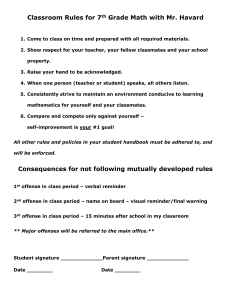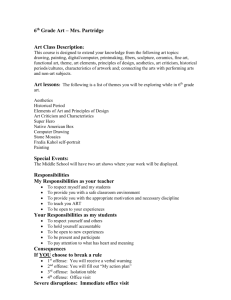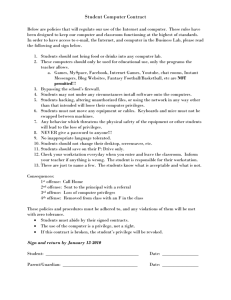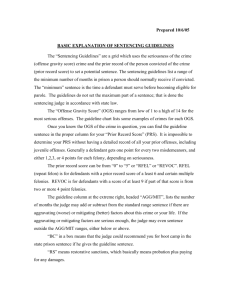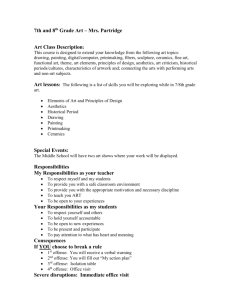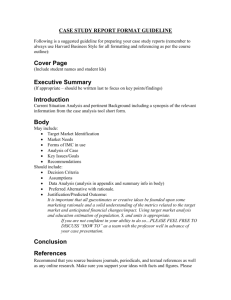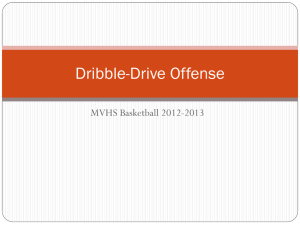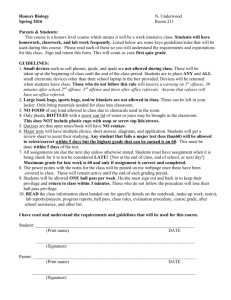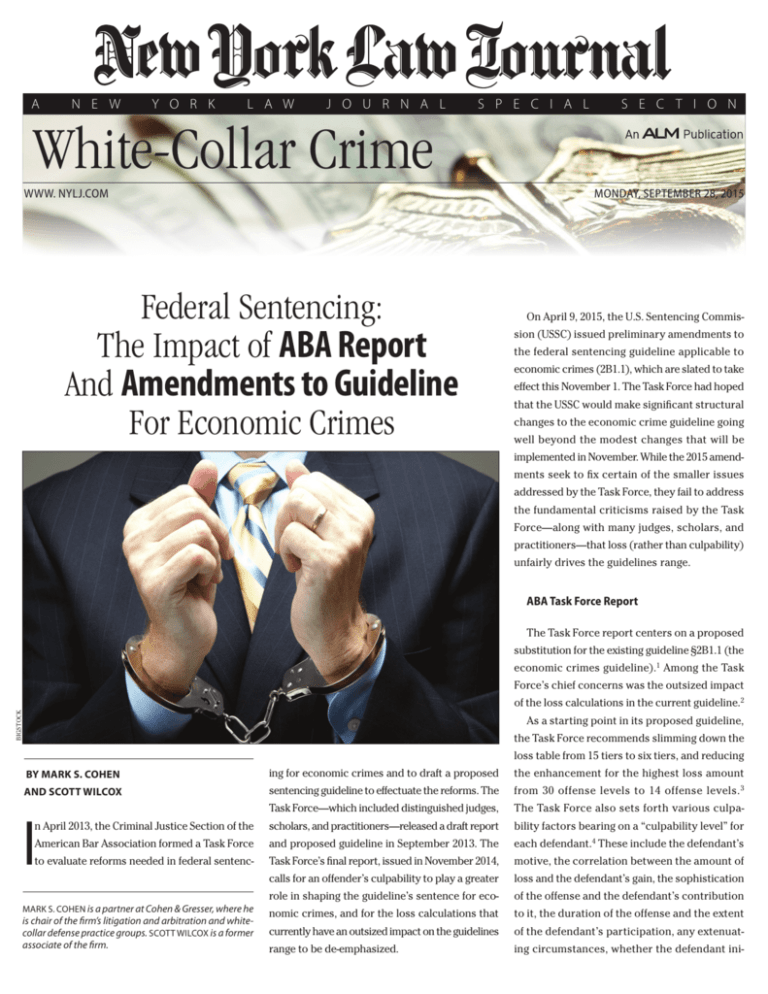
A
N E W
Y O R K
L A W
J O U R N A L
S P E C I A L
S E C T I O N
White-Collar Crime
MONDAY, SEPTEMBER 28, 2015
www. NYLJ.com
Federal Sentencing:
The Impact of ABA Report
And Amendments to Guideline
For Economic Crimes
On April 9, 2015, the U.S. Sentencing Commission (USSC) issued preliminary amendments to
the federal sentencing guideline applicable to
economic crimes (2B1.1), which are slated to take
effect this November 1. The Task Force had hoped
that the USSC would make significant structural
changes to the economic crime guideline going
well beyond the modest changes that will be
implemented in November. While the 2015 amendments seek to fix certain of the smaller issues
addressed by the Task Force, they fail to address
the fundamental criticisms raised by the Task
Force—along with many judges, scholars, and
practitioners—that loss (rather than culpability)
unfairly drives the guidelines range.
ABA Task Force Report
The Task Force report centers on a proposed
substitution for the existing guideline §2B1.1 (the
economic crimes guideline).1 Among the Task
Force’s chief concerns was the outsized impact
BIGSTOCK
of the loss calculations in the current guideline.2
As a starting point in its proposed guideline,
the Task Force recommends slimming down the
loss table from 15 tiers to six tiers, and reducing
By Mark S. Cohen
ing for economic crimes and to draft a proposed
the enhancement for the highest loss amount
and Scott Wilcox
sentencing guideline to effectuate the reforms. The
from 30 offense levels to 14 offense levels. 3
Task Force—which included distinguished judges,
The Task Force also sets forth various culpa-
n April 2013, the Criminal Justice Section of the
scholars, and practitioners—released a draft report
bility factors bearing on a “culpability level” for
American Bar Association formed a Task Force
and proposed guideline in September 2013. The
each defendant.4 These include the defendant’s
to evaluate reforms needed in federal sentenc-
Task Force’s final report, issued in November 2014,
motive, the correlation between the amount of
calls for an offender’s culpability to play a greater
loss and the defendant’s gain, the sophistication
role in shaping the guideline’s sentence for eco-
of the offense and the defendant’s contribution
nomic crimes, and for the loss calculations that
to it, the duration of the offense and the extent
currently have an outsized impact on the guidelines
of the defendant’s participation, any extenuat-
range to be de-emphasized.
ing circumstances, whether the defendant ini-
I
Mark S. Cohen is a partner at Cohen & Gresser, where he
is chair of the firm’s litigation and arbitration and whitecollar defense practice groups. Scott Wilcox is a former
associate of the firm.
MONDAY, SEPTEMBER 28, 2015
tiated the offense, and whether the defendant
Judge Janet C. Hall, while not applying the Task
rather than considering such intended losses
took any steps to mitigate the harm from the
Force’s proposed guideline wholesale, observed,
in the aggregate.”17
5
offense. Applying these factors, the offense
in United States v. Litvak, that the Task Force’s
In amending the definition, the USSC dismissed
level of the lowest culpability offender would
discussion of the factors impacting a defendant’s
concerns from the U.S. Department of Justice hat
be reduced six to 10 levels, while the offense
culpability was very helpful in her determination
the change would “effectively eviscerate use of
level of the highest culpability offender would
of a fair sentence.
12
6
be increased six to 10 levels. The culpability
factor would not impact the offense level of a
the intended loss criterion in determining loss.”18
Specifically, the DOJ had argued:
2015 Amendments
moderate culpability offender, and a three to
Application of the subjective standard
adopted in the proposed amendment will
five level adjustment up or down, respectively,
Absent congressional action, the USSC’s 2015
make it difficult, if not impossible, to prove
would be applied to the offense levels of high
amendments to the economic crimes guideline
any amount of intended loss, even in cases
and low culpability offenders.7
will take effect this November 1. These include,
where the evidence shows grossly reckless
inter alia, revisions to the definition of intended
conduct that evidences genuine culpability,
To address the issue of guideline sentences of
incarceration for first-time offenders, the Task
and will lead to the adoption of an actual loss
Force recommended an offense level cap of 10
standard in the great majority of criminal
for non-serious offenses by first-time offenders.8
In other words, if a first-time offender committed
a non-serious offense, his or her offense level
would be no greater than 10 and a sentence other
than imprisonment would generally be appropriate under the Task Force’s proposed guideline.9
Although the USSC did not adopt the more
significant structural changes proposed by the
The Task Force report centers on a
proposed substitution for the existing guideline §2B1.1 (the economic crimes guideline). Among the
Task Force’s chief concerns was the
outsized impact of the loss calculations in the current guideline.
fraud cases.19
Despite the DOJ’s arguments, we expect intended loss to continue to factor into sentencing
for economic crimes in certain cases. Although
accepting the Task Force recommendation to
define “loss” as “actual loss” would better ensure
that the loss calculations are aligned with the
Task Force, the Task Force report arguably did
defendant’s culpability, the subjective inquiry
influence the 2015 amendments to the economic
is a welcome shift, which should enable some
crime guideline to some extent. The USSC sought
loss, to the criteria for the victim table, and to
defendants to cabin the loss amount attributed
in those amendments to address some of the
the definition of sophisticated means.
to their conduct at sentencing.
smaller issues addressed by the Task Force, as
will be further described below.
Intended Loss. Because loss can have such
Victim Table. The USSC’s amendment introduc-
an outsized effect under the guideline, the defi-
es a concept of “substantial financial hardship” to
The Task Force report also in its own right
nition of “loss” is particularly important. The
the offense characteristic for impact on victims
has influenced some sentencing decisions, and
economic crimes guideline provides that loss is
(also known as the victim table).20 The existing
likely will continue to do so. Even before the
generally “the greater of actual loss or intended
guideline provides for a two-level enhancement
Task Force issued its final report, two federal
loss.”13 The amendment defines “intended loss” to
if the offense involved 10 or more victims or was
district judges had explicitly referenced the pre-
include “the pecuniary harm that the defendant
committed through mass-marketing; a four-level
liminary Task Force report or its methodology
purposely sought to inflict.”14 This new definition
enhancement if the offense involved 50 or more
as instructive in determining a fair sentence for
calls for a subjective inquiry, in the wake of a
victims; and a six-level enhancement if the offense
a white-collar defendant. For example, U.S. Dis-
circuit split concerning whether the existing defi-
involved 250 or more victims.21
trict Judge Robert N. Chatigny, in United States v.
nition calls for subjective or objective analysis.
The amendment provides that the two-lev-
Rivernider, applied the methodology of the Task
The USSC failed to heed the Task Force’s
el enhancement also will apply if the offense
Force’s proposed guideline before awarding a
recommendation to define loss only as “actual
results in substantial financial hardship to
sentence at the upper end of the Task Force range
loss.”15 However, the Task Force nonetheless
one or more victims.22 The four- and six-level
(12 years) as opposed to the sentence he calcu-
supported the USSC’s definitional change as
enhancements will be changed to require a
lated pursuant to the USSC guideline (more than
preferable to an objective inquiry.16 The Task
showing that the offense resulted in substantial
twice that, i.e., 324 to 405 months). Chatigny
Force argued to the USSC that, if intended loss
financial hardship for at least five or at least
noted that the “guidance provided by the [Task
were to factor into the guideline calculation at
25 victims, respectively.23
Force] approach is preferable to what emerge[d]
all, “[t]o better individualize the culpability of
The amendment sets forth a non-exhaustive
from the existing guideline,” which he believed
each criminal participant in an offense, the loss-
list of factors that a court should consider in
“significantly overstate[d the defendant’s] cul-
es intended to be inflicted by each participant
determining whether a victim has sustained
pability for a number of reasons.”11 U.S. District
should be used as the measure of culpability,
“substantial financial hardship.”24 These include
10
MONDAY, SEPTEMBER 28, 2015
••••••••••••••••
•••••••••••••
becoming insolvent, filing for bankruptcy, suffer-
argued that the sophisticated means enhance-
ing substantial loss of a retirement, education, or
ment “should not be limited to cases in which
other savings or investment fund, making sub-
the defendant personally used the sophisticated
stantial changes to employment (e.g., postponing
means.”31 Specifically, the DOJ observed that “[h]
retirement plans), making substantial changes
olding the defendant liable for foreseeable con-
2. Id. at 1-6.
to living arrangements (e.g., relocating to a less
duct of accomplices done in furtherance of …
3. Id. at i.
expensive home), and suffering substantial harm
jointly undertaken activity is hardly novel,” and
to the ability to obtain credit.25
“most courts to have considered the issue have
1. American Bar Association Criminal Justice Section, A
Report on Behalf of the American Bar Association Criminal
Justice Section Task Force on the Reform of Federal Sentencing for Economic Crimes (Nov. 10, 2014) (ABA Report), at i.
4. Id. at 1-5.
5. Id. at 1.
6. Id. at i.
The Task Force had recommended that the
held that the sophisticated means enhancement
7. Id.
victim table be removed from the guideline,
applies to a particular defendant so long as the
8. Id. at i, 6.
because “[u]nder ordinary circumstances the
use of sophisticated means by other criminal
harm suffered by the victims of an economic
associates was reasonably foreseeable to the
No. 3:10CR222 (D. Conn. Dec. 18, 2013), at 200:4-7, 212:5-20,
crime is fully accounted for by consideration of
defendant.”32
216:17-18.
26
As the Task Force argued, the amendment’s
Nevertheless, the Task Force supported as an
narrowing the sophisticated means enhancement
alternative the USSC’s amendment to introduce
is an appropriate step toward better linking the
the concept of substantial financial harm into
defendant’s culpability to his or her offense level,
the existing victim table.27
and an improvement to the existing guidelines.
the amount of the loss caused by the offense.”
10. Tr. of Sentencing Hearing, United States v. Rivernider,
11. Id. at 206:10-13, 212:5-14.
12. Tr. of Sentencing Hearing, United States v. Litvak, No.
3:13cr19 (D. Conn. July 23, 2014), at 136:12-137:2.
13. U.S. Sentencing Commission, Guidelines Manual,
§2B1.1 (Nov. 1, 2014) (2014 Guidelines Manual), cmt. (n.3(A)).
14. U.S. Sentencing Commission, Amendments to the Sentencing Guidelines (Preliminary) (April 9, 2015) (Preliminary
Although eliminating the victim table altogether would avoid the double-counting that often
9. Id.
Implications
occurs when the loss table and victim table calcu-
Amendments), §2B1.1, cmt. (n.3(A)(ii)).
15. ABA Report, supra note 1, at 1.
16. Testimony of James E. Felman on behalf of the Ameri-
lations are combined, the amendment’s require-
Although the Task Force report and other calls
can Bar Association before the U.S. Sentencing Commission
ment of substantial financial hardship at least
for reform in sentencing policy for economic
for the Hearing on Proposed Amendments to the Federal Sen-
seeks to ensure some culpability as a prerequisite
crimes have not yet led the USSC to significantly
to the greater enhancements for impact on a
amend the economic crimes guideline, this is an
victim, which is a positive step.
area to continue to watch closely as the guide-
18. Letter from Jonathan J. Wroblewski, Director, Office
Sophisticated Means. The existing guideline
lines continue to evolve in coming years. In the
of Policy and Legislation, U.S. Department of Justice to the
provides for an enhancement if “the offense oth-
meantime, the 2015 amendments to the guideline
Honorable Patti B. Saris, Chair, U.S. Sentencing Commission
erwise involved sophisticated means.”28 Courts
for economic crimes will give courts additional
have applied this enhancement even if the defen-
latitude within the sentencing guideline regime,
20. Preliminary Amendments, supra note 14, §2B1.1(b)(2).
dant’s own conduct was not sophisticated. The
in appropriate cases, to lessen the historically
21. 2014 Guidelines Manual, supra note 13, §2B1.1(b)(2).
amendment narrows the scope of this enhance-
harsh impact of the guideline for economic crime.
22. Preliminary Amendments, supra note 14, §2B1.1(b)(2).
ment so that it applies only in cases in which “the
Courts should continue to heed the advisory
defendant intentionally engaged in or caused the
nature of the guidelines, particularly in cases
conduct constituting sophisticated means.”29
involving economic crime, where the combination
26. Felman Testimony, supra note 16, at 15.
The Task Force had recommended that the
of the loss table and specific offense characteris-
27. Id.
USSC eliminate the standalone sophisticated
tics sometimes leads to double- or triple-counting
means enhancement, and that the use of sophis-
of certain factors, causing the defendant’s offense
ticated means impact the offense level only as
level to exceed his or her culpability. As they
30. Felman Testimony, supra note 16, at 15.
one of the factors bearing on the defendant’s cul-
seek to fashion appropriate sentences, we expect
31. Wroblewski Letter, supra note 18, at 33.
pability. The Task Force nonetheless supported
additional judges, in appropriate cases, to rely
the definitional change to be made through the
on the Task Force report or its methodology in
amendment as an improvement to the existing
sentencing offenders covered by the economic
language. The Task Force argued to the USSC that
crimes guideline. Over time, we expect the USSC
“defendants’ culpability is much more justifiably
to adopt additional reforms proposed in the Task
increased when they are themselves responsible
Force report, including a slimming-down of the
for the sophistication of the offense.”30
loss table to include fewer tiers and other amend-
In adopting the amendment, however, the USSC
dismissed the concerns of the DOJ, which had
ments to better match the offense level to the
defendant’s culpability.
tencing Guidelines Regarding Economic Crimes (March 12,
2015) (Felman Testimony), at 14-15.
17. Id.
(March 9, 2015) (Wroblewski Letter), at 28.
19. Id. at 29.
23. Id.
24. Id., §2B1.1, cmt. (n.4(F)).
25. Id.
28. 2014 Guidelines Manual, supra note 13, §2B1.1(b)(10).
29. Preliminary Amendments, supra note 14, §2B1.1(b)
(10).
32. Id.
Reprinted with permission from the September 28, 2015 edition of the NEW YORK
LAW JOURNAL © 2015 ALM Media Properties, LLC. All rights reserved. Further
duplication without permission is prohibited. For information, contact 877-257-3382
or reprints@alm.com. # 070-09-15-34


